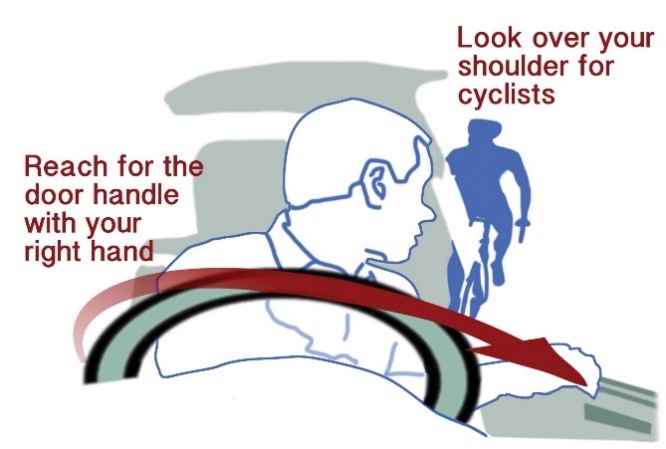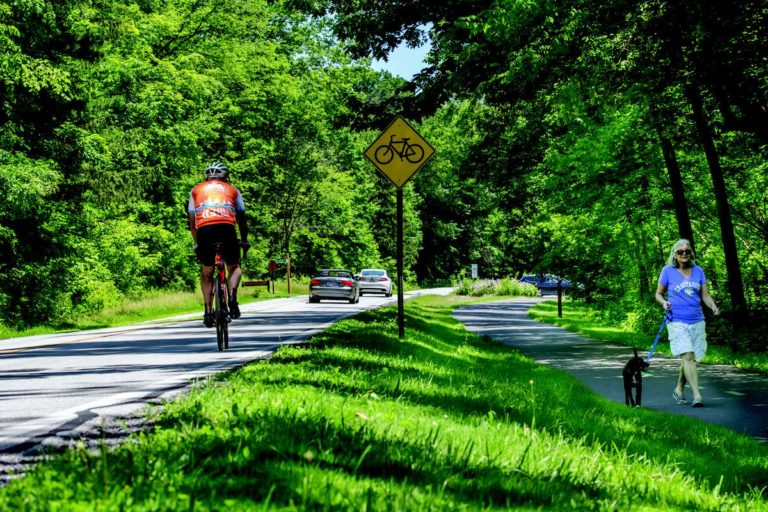© Keith Berr Productions, Inc. 216.566.7950 www.keithberr.com All Rights Reserved
This particular article focuses on the drivers, not the cyclists. Cyclists also have duties and responsibilities for riding safely on the road. However, for numerous reasons it is imperative for motorists to drive safely around cyclists.
Bikes are vehicles and entitled to ride on most public roads just like cars. The following speaks to what drivers should know and do around cyclists for responsible driving.
Avoid distraction: be aware!
Awareness of your surroundings is the best tool for avoiding a crash. A crash can occur with a cyclist, pedestrian, car or fixed object! Keep your eyes on the road, look for what is up ahead. Consider and look for bikes and pedestrians. Adjust for sun glare and don’t get distracted!
Distracted driving occurs if you are late or in a hurry. Maybe you dropped something on the floor or are taking an important phone call while driving. Maybe you are worried big-time about something else. Other causes of distracted driving are searching for better music, or being lost or unsure of where you are going. Or maybe you simply use text-based communication for that dinner reservation! These excuses are likely violations of Ohio law that defines driving distracted an anything unnecessary to actual driving. They are also dangerous and could be deadly in a distracted driving crash.
Being in the present moment and staying focused can prevent distracted driving. Awareness of your surroundings is KEY! Remember, you are driving a 2000-pound machine with numerous safety devices while a cyclist and a pedestrian have almost no protection. Who stands to lose the most? Obviously, the cyclist and pedestrian but it will also cost the driver in terms of civil and/or criminal and moral responsibility.
What are Ohio Laws for Motorists Sharing the Road with Cyclists?
Ohio’s minimum safe passing distance
In 2017 Ohio’s Three Feet Safe Passing law went into effect. When passing cyclists, drivers are required to be at least three feet away. In Cleveland this distance becomes a minimum of six feet, for a commercial motor vehicle/truck/unit/bus passing cyclists. Why? Because a cyclist needs room to move over to avoid road hazards, by the way. And you as a driver need the extra clearance. The faster you are driving, the more room you should give cyclists in traffic!
Crossing over a double yellow line to pass cyclists
- The cyclist is traveling at less than half the posted speed limit
- The motorists shall not exceed the speed limit while making the pass, and
- There is sufficient clear sight distance for the driver to make the pass safely
- Three Feet Safe Passing Distance and Legal Passing on a Double Yellow
Types of Bike Crashes We See in Our Bike Law Practice, and How Drivers Can Avoid Causing Them!
A right hook #1 occurs when a driver, failing to look behind them, turns right into an oncoming cyclist. The driver may think the cyclist is much farther back than where they last saw the cyclist, vs. where the cyclist actually is on the road.
Drivers should take care when passing cyclists and be sure not to turn right in front of them, either. This is called a right hook #2 and happens when a driver fails to gauge a cyclist’s speed and abruptly cuts a cyclist off. It usually results in serious injury to the vulnerable cyclist yet just a minor scratch on the driver’s car. With e-bikes on the road, what looks like a slow cyclist can really end up surprising a driver regarding the speed the e-bike can move—a class 3 e-bike can go 28 mph or even higher.
Left turns can also be problematic because a driver may not look for oncoming cyclists, or the cyclist is hidden behind a row of vehicles and, if the driver is not paying attention, comes into view when it’s too late.
Rear-enders are devastating to cyclists hit by a two-thousand-pound vehicle and often result in very serious injury. Drivers should pay attention to all the road in front of them, especially off to the right where cyclists normally ride. Even if a cyclist is riding on the berm, the cyclist could easily move back onto the road and into the path of the driver who is not watching or not aware that this could happen.
Distracted Driving and the Law
Driving while distracted is dangerous enough to be known as “the new drunk driving”!
Distracted driving includes non-hands-free texting and, as mentioned earlier, any activity not necessary to operating a vehicle, ORC § 4511.991 Ohio is moving toward making distracted driving a primary offense, i.e., allowing a police officer to cite a motorist who is distracted yet not committing any other traffic offense. Some cities, including Lakewood, have already written this into law, Lakewood Ordinance § 331.345
Ohio House Bill 283 introduced in 2021 is the most current legislation and the stronger of the two distracted driving bills before our Ohio General Assembly. Hopes are high that it will be enacted later this year and we will at long last see a distracted driving law cover a primary traffic offense.
What are Safety Benefits of Defensive Driving?
All types of drivers can benefit from driving defensively! One drives defensively by continually identifying what’s going on around your vehicle, including what other drivers, pedestrians and cyclists are doing, what’s going on up ahead, even areas where street repair might be needed so you can skirt around these hazards.
New habits should be developed behind the wheel. As a defensive driver you continually adjust to maximize visibility and space, giving you extra time to react, and often, to avoid a crash. Adding safe driving practices includes three key defensive driving habits:
- Looking Ahead: “Look up” higher than you normally do, while driving to the point down the road where your vehicle will be eight to twelve seconds in the future, to identify the most hazards
- Keeping Head & Eyes Moving: Turn your sense of sight into “radar” continuously moving left and right as you proceed down the road, “scanning” for anything that could pose the risk of a crash and giving you plenty of time to react; especially important in urban environments, parking lots, places where pedestrians and/or cyclists might be
- No Tailgating–Maintain Safe Following Distance: Ohio is in the top 10 in the U.S. for tailgating violations!
How Can a Motorist Avoid “Dooring” a Cyclist?
Dooring happens when a driver opens the door of their parked motor vehicle right into an oncoming cyclist, without looking to make sure the coast is clear of bike traffic.
Ohio law states that “No person shall open the door of a vehicle on the side available to moving traffic unless and until it is reasonably safe to do so, and can be done without interfering with the movement of other traffic” and as we know, bikes are traffic.
Dooring Hazard
A technique known as the Dutch Reach can make all the difference in protecting passing cyclists from injury, and yourself from a lawsuit.
We tend to open our driver’s side doors with our left hand but opening them with our right hand is so much safer. It causes the body to pivot, providing an automatic view of the blind spot and who/what might be coming along the road from behind. Give it a try, then make it a habit!

Beware the sun glare!
Early fall is especially dangerous for cyclists because drivers can be blinded by the setting sun. Drivers should be aware of sun glare and wear eye protection (polarized sunglasses) to increase visibility. A driver should never drive blind, even for a few seconds. Pull over and get your eyes adjusted so you can see what’s ahead.
Ken Knabe, Greater Cleveland’s Bike Attorney: Serves and protects injured cyclists from the ground, up! 14222 Madison Avenue, Lakewood, OH 44107 * 216-228-7200

